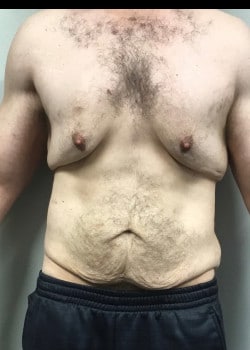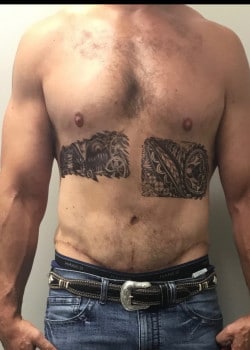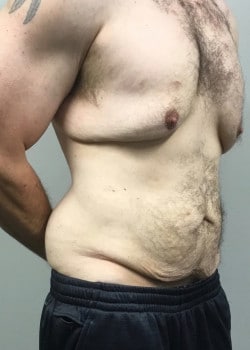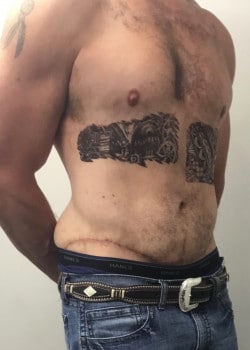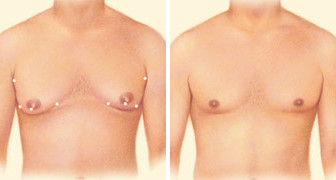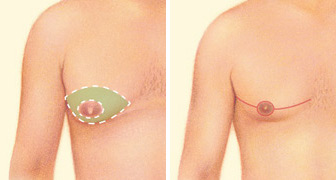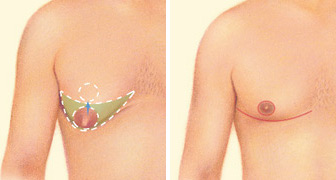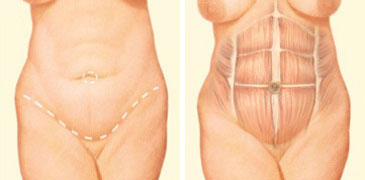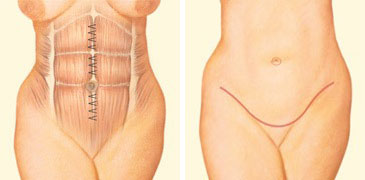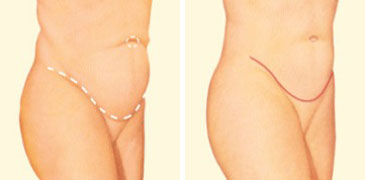GYNECOMASTIA REDUCTION AND TUMMY TUCK AFTER MASSIVE WEIGHT LOSS
Individual results may vary.
Case ID: 3814This patient came to see Dr. Medalie complaining of severe gynecomastia and lateral excess skin and fatty tissue as well as excess skin of the abdomen. He had lost a great deal of weight and was concerned about the displaced nipple/areolar complex, excess breast tissue and lateral excess skin and fatty tissue. His male breast reduction surgery was performed on an outpatient basis.He had a complete double mastectomy with nipple areolar reconstruction by grafting and side and chest liposuction. His incisions were extended quite far on his sides in order to remove the excess lateral skin as well. The patient is shown 4 months after his procedure. His chest contour is much improved and his nipples are smaller and in a better position. His abdomen is much tighter ands the excess lower skin is gone. He is working out and lifting weights and has excellent body aesthetics from his body contouring procedure.He is extremely pleased with his outcome. The tattoos are temporary to see how they would look in the future.*Plastic Surgery results are not guaranteed
Below is information provided by the American Society of Plastic Surgery:
What Is Gynecomastia Surgery?
Gynecomastia surgery reduces breast size in men, flattening and enhancing the chest contours.
In severe cases of gynecomastia, the weight of excess breast tissue may cause the breasts to sag and stretch the areola (the dark skin surrounding the nipple). In these cases the position and size of the areola can be surgically improved and excess skin may be reduced.
Plastic surgery to correct gynecomastia is technically called reduction mammaplasty.
What Is Gynecomastia?
Gynecomastia is a condition of overdeveloped or enlarged breasts in men that can occur at any age. The condition can be the result of hormonal changes, heredity, obesity or the use of certain drugs.
Gynecomastia can cause emotional discomfort and impair your self-confidence. Some men may even avoid certain physical activities and intimacy simply to hide their condition.
Gynecomastia is characterized by:
- Excess localized fat
- Excess glandular tissue development
- Sometimes excess breast skin
- Presence unilaterally (one breast) or bilaterally (both breasts)
-
What Are The Steps Of A Gynecomastia Procedure?
A male breast reduction procedure includes the following steps:
Anesthesia
Medications are administered for your comfort during the surgical procedures. The options include intravenous sedation and general anesthesia. Your doctor will recommend the best option for you.
Liposuction Technique
In cases where the chest tissue is primarily the result of excess fatty tissue, liposuction techniques alone may be used. This requires insertion of a cannula, a thin hollow tube, through several small incisions.
The cannula is moved back and forth in a controlled motion to loosen the excess fat, which is then removed from the body by vacuum suction.
There are various liposuction techniques that may be used; the technique most appropriate in your case will be defined prior to your procedure.
Excision Technique
Excision techniques are recommended where glandular breast tissue or excess skin must be removed to correct gynecomastia. Excision also is necessary if the areola will be reduced or the nipple will be repositioned to a more natural male contour. Incision patterns vary depending on the specific conditions and surgical preference. I find that almost always a patient will need a small incision to remove glandular tissue under the nipple. I try to make the incision at the areolar skin junction on the lateral border of the areola from 6-12 o’clock.
Combination Of Liposuction & Excision Techniques
Sometimes gynecomastia is treated with both liposuction and excision. This is the case in the example above when there is both excess fatty tissue and glandular tissue present.
What are the steps of a tummy tuck procedure?
A tummy tuck procedure includes the following steps:
Step 1 – Anesthesia
Medications are administered for your comfort during the surgical procedures. The choices include intravenous sedation and general anesthesia. Your doctor will recommend the best choice for you.
Step 2 – The incision
A full tummy tuck requires a horizontally-oriented incision in the area between the pubic hairline and belly button.
The shape and length of the incision will be determined by the amount of excess skin. Once the abdominal skin is lifted, the underlying weakened abdominal muscles are repaired.
A second incision around the navel may be necessary to remove excess skin in the upper abdomen.
The upper abdominal skin is pulled down like a window shade. The excess skin is trimmed and the remaining skin is sutured together. A new opening for the belly button is created. The belly button is popped through to the surface and sutured into position.
Step 3 – Closing the incisions
Sutures, skin adhesives, tapes or clips close the skin incisions.
Step 4 – See the results
Your tummy tuck will result in a flatter, firmer abdominal contour that is more proportionate with your body type and weight. Get more information about tummy tuck results.
